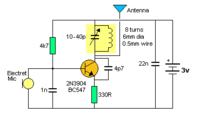I14R10
Full Member level 3
I tried searching and asking questions on few forums, but I didn't get an answer. Simple question
In oscillators, like this one

what is the amplitude of oscillations at collector? LTSpice simulation shows that it's almost rail to rail, but I would like to know what is the case in real life? Are oscillations really rail to rail?
In oscillators, like this one

what is the amplitude of oscillations at collector? LTSpice simulation shows that it's almost rail to rail, but I would like to know what is the case in real life? Are oscillations really rail to rail?

